Over the years, the format of Argentina’s top-flight football has experienced numerous changes, with those in charge constantly trying to switch things up in a bid to boost the reputation and financial benefits of the Primera División. While the division itself has lacked consistency in that sense, there has been a regularity in terms of successful teams. River Plate are the leaders when it comes to the number of league titles, with 37 to their name — Boca Juniors are a close second after the club claimed their 35th title in the 2022 season. However, despite their continued success since the league’s formation, Boca are this season going through a rough patch, with Xeneize currently sitting 11th in the table as the season’s climax draws close.
This scout report will provide a tactical analysis of Boca Juniors, aiming to pinpoint the main reasons behind their failure this season and whether or not it is strongly related to their tactics. The analysis will focus on their attacking performance throughout the season, even though they went through a change in manager back in March — Hugo Ibarra was relieved of his duties and replaced by current boss Jorge Almirón, who most recently managed Elche in Spain’s LaLiga before taking this role. We have highlighted the attacking side of their game for analysis, as the data suggests they are below par in this area. We will also include some bright spots from their 2023 league data — stats highlighting positive areas for Boca that they could use more often in their general play.
Season overview to date
As mentioned, Boca sit in 11th place at the time of writing, a far cry from their triumph in the previous season. Their record paints the picture of a team who have failed to find a consistent form — nine wins from 23, with as many defeats. While their defensive record isn’t a huge problem (22 goals conceded), their goal tally of 25 is part of why they find themselves in this mess.
We touched on the change in manager earlier in the season — Ibarra took charge of eight games this season, pickup up just 11 points, leading the club’s hierarchy to take action. Since Almirón’s arrival, they have picked up nine wins from 18, losing six. While there was some improvement in results, inconsistency was still an issue, as was their fortune in front of goal. 4-3-3 has been their primary formation for the whole season, with the occasional use of a range of similar shapes.

Lack of attacking firepower
After 23 league games thus far, Boca have had nine games where they failed to score — far too many missed opportunities for extra points. While there are other teams with worse attacking records than Boca, they should not be satisfied with simply being better with some of the teams around them in the middle of the table. Their defensive record is more than satisfactory and is, in fact, better than some of the teams at the upper end of the table, so it is only fair to say their attacking output is letting them down.
Regarding playing style & tactics, Boca are a possession-based team and show quality in the early phases of build-up/possession. Their reliability in these stages is undeniable — they rank 3rd best in the league for ball losses per 90, and they have the best pass accuracy in the division with 85.3%. They also rank third for highest average possession. Those numbers make it clear that they are strong on the ball in general. Still, I know what you’re thinking; those stats, in particular, don’t shed any light on how efficient they are at progressing the ball into attacking areas. Still, they have so far recorded the second-highest accuracy with passes into the final third (74%). This only adds evidence to the notion that their struggles lie in the final third, so let’s look at their performance in front of goal.
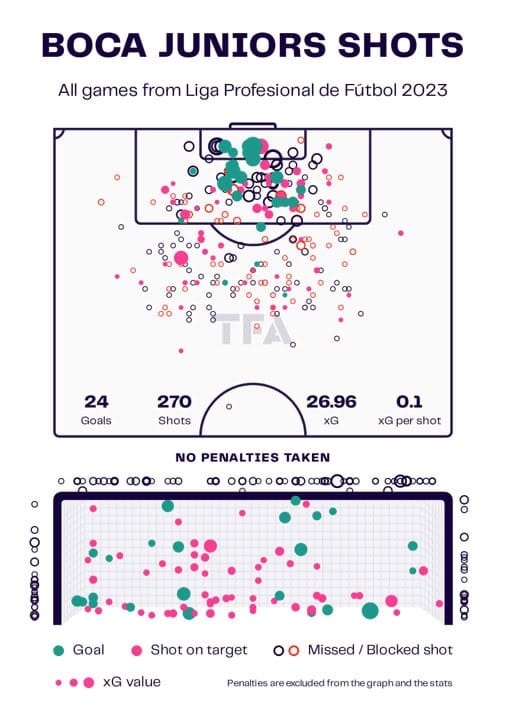
A number of red flags pop up in relation to the above shot map. From underperforming their xG to taking too many long shots, there is definitely room for improvement in this department. Long shots are a welcome sight in football and provide incredible moments that last a lifetime, but it seems that Boca are trying to utilise them all too much – often at a ridiculous range too.
Their accuracy rate is cause for concern as well. Their xG per shot of 0.1 essentially sees them scoring one shot from each 10 they take, but the poor stats don’t stop coming there. While Boca rank 7th in the league for the number of shot attempts per 90, indicating a good level of attacking engagement, they sit amongst the league’s worst when it comes to shot accuracy: they have an efficiency issue there. We know that a lot of these shots are wild long-range efforts, and we also know that Boca struggle to consistently have a dangerous presence in the box — the data tells us that 14 teams in the league rank higher in terms of touches in the box per 90. While it is true that you don’t need loads of touches in the box to be effective, having more of a presence in those areas would benefit Boca, especially if they insist on sticking with their possession-based game.
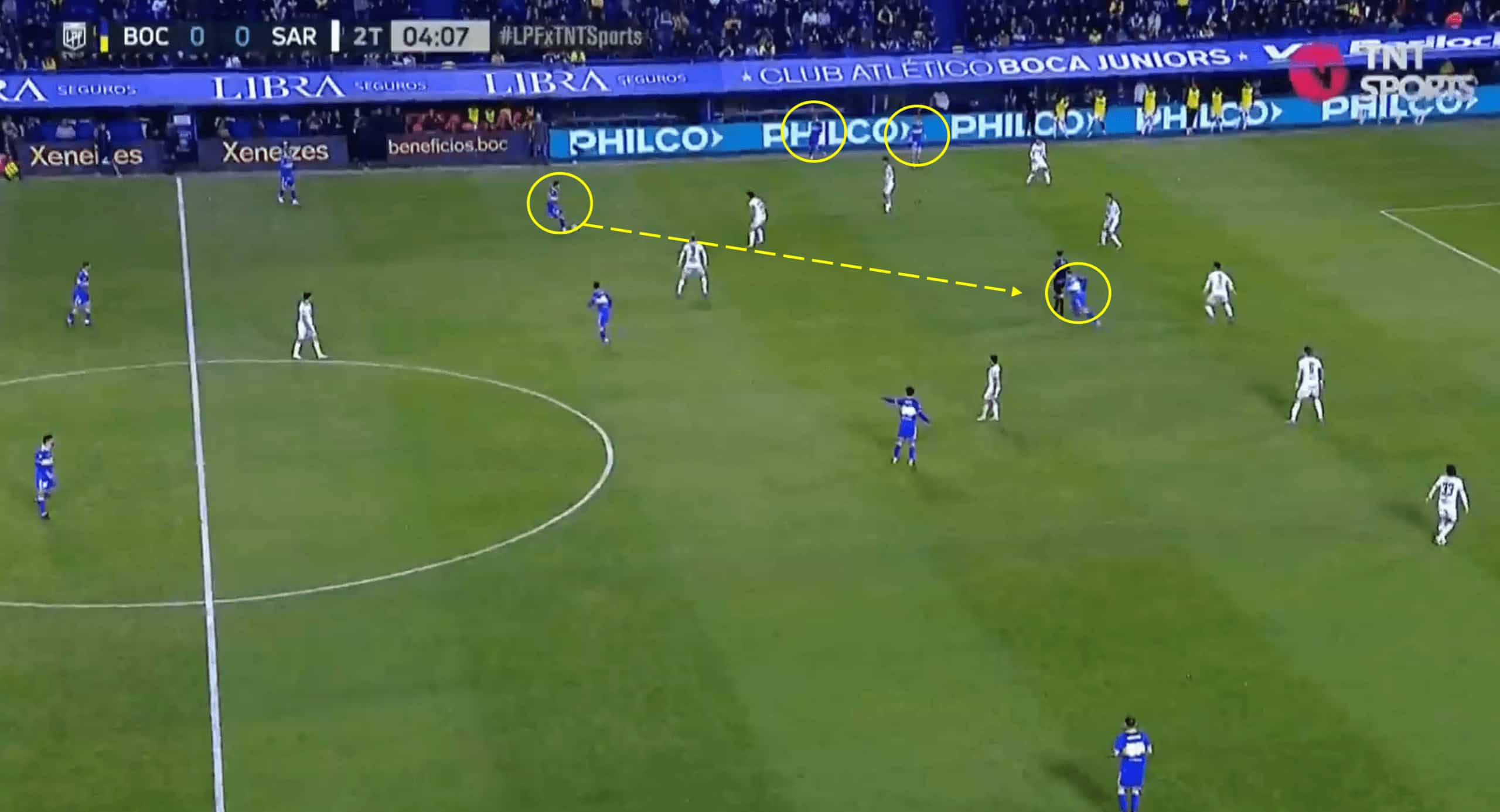
The terms “inconsistent” and “poor decision-making” will crop up a fair bit in this scout report, as they are two of Boca’s most significant problems this season. Take the example above. At face value, the pass into the striker who dropped into the whole may seem like a sensible move to try and progress the attack, but let’s go through a couple of points about why it wasn’t the best decision.
Sure, he has the chance to receive the ball in plenty of space (apart from the opposition defender who closely follows behind, eliminating the chance of the attacker turning and driving forward). Still, he has no support from teammates, significantly lowering the odds of turning this possession phase into a dangerous attack. Moreso, Boca, who tend to fluctuate between focusing their play through the centre and down the flanks, have two players hugging the touchline in the image above, so it would make sense to bring them into play as they enter the final third, but we didn’t see this of course. Solution? If they insist on bringing the striker into play in scenarios like this one, he may want to position himself slightly wider to create the opportunity of linking up with the two wide men.
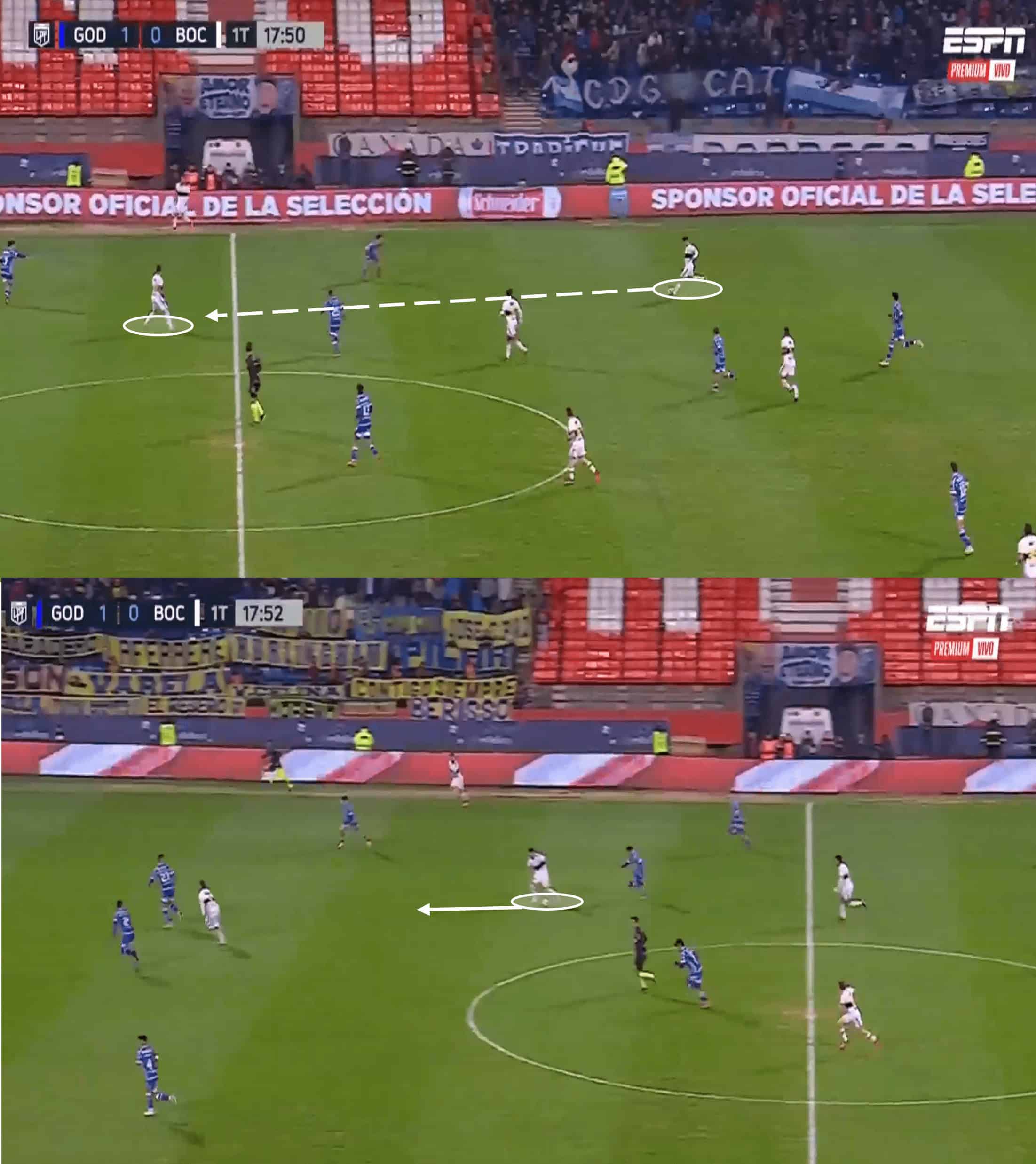
Boca have developed a real talent in playing line-breaking passes through central areas, but they are still yet to crack the code for what to do after that. The pass came in a general possession phase. While we are here to pick Boca apart essentially, we must give credit where it is due — their players, mainly the midfield bunch, have some outstanding individual moments. They show excellent technical ability in some situations and clever positioning & off the ball movement in others; this included the latter. The Boca midfielder did well to find space behind the opposition midfield unit, giving him space ahead to run into before encountering their defenders…
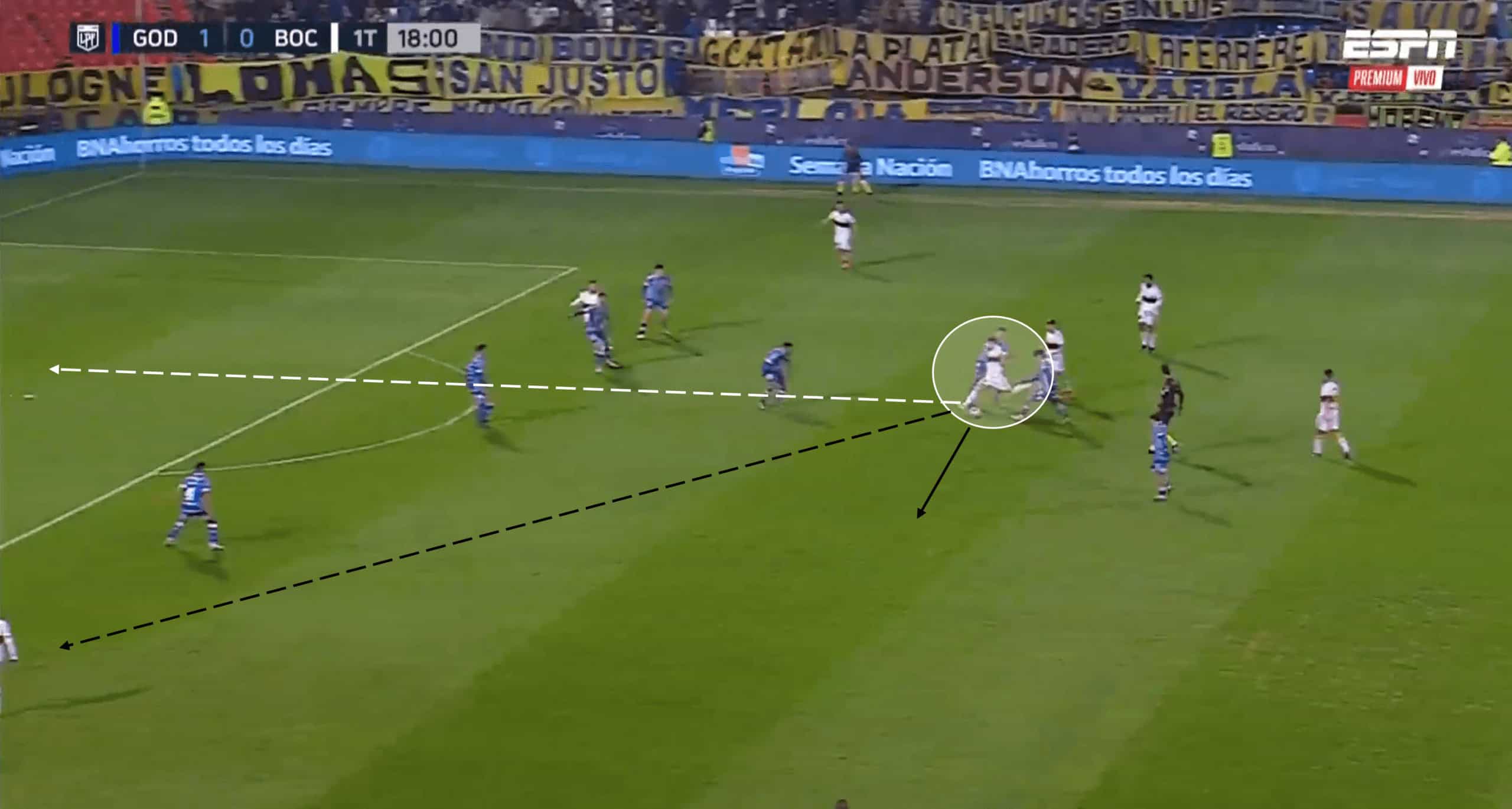
For a move that held so much promise, to ruin it with a desperate long shot is a real shame, but not out of the ordinary for Almirón’s team this season. There isn’t even the excuse of having no support, as there was a teammate (just out of shot in the bottom left) in good space — the player even had the option of driving to the left slightly to break free of the opposition swarm. To simply fire a long shot from there is such a waste of an attacking opportunity.
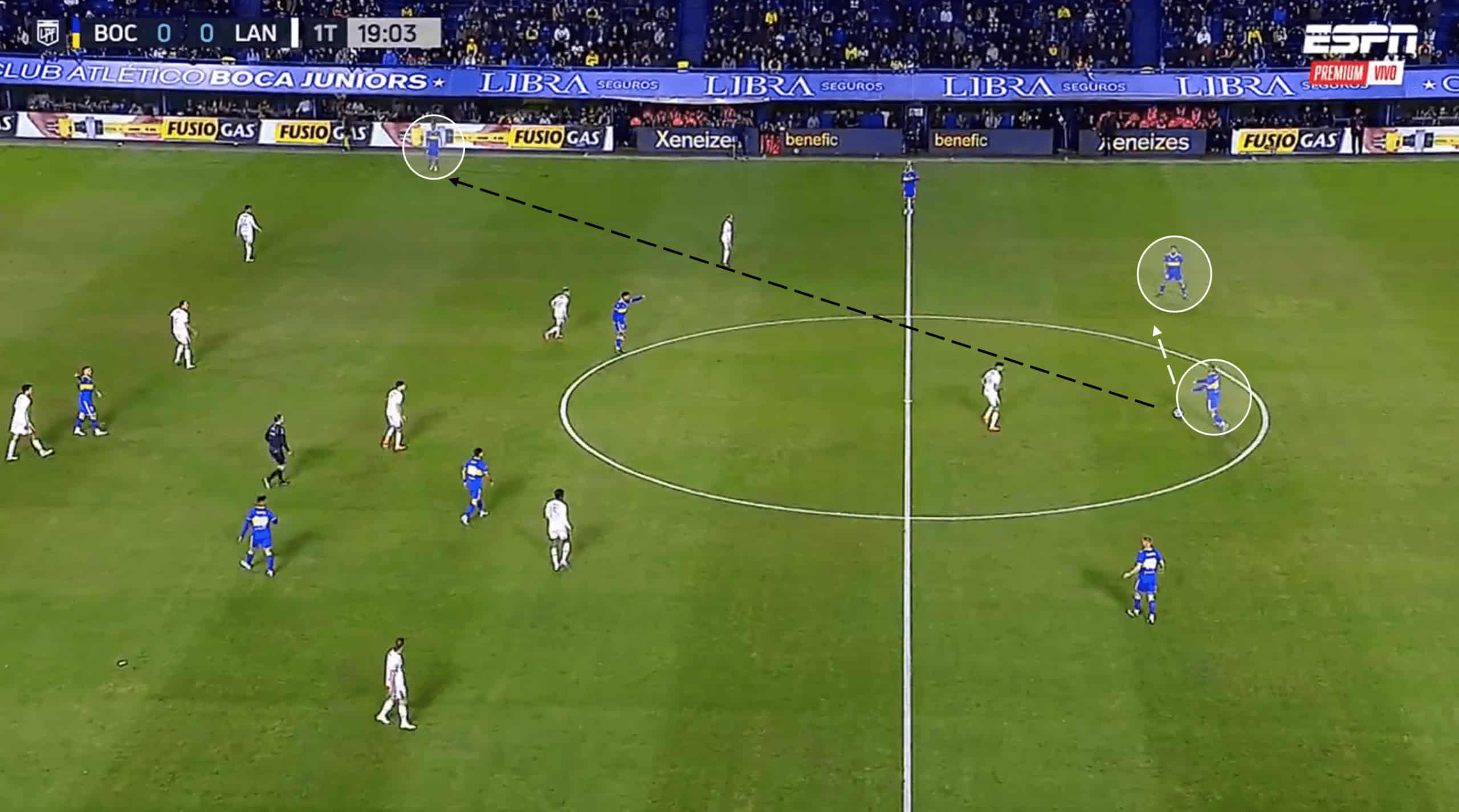
One of the most essential weapons in a team’s arsenal is the ability to initiate a plan B when plan A isn’t cutting it, which is something Boca have struggled with. Yes, they are capable of controlling large portions of possession. If you were to sift through the various passing data that isn’t included in this scout report, you’d get the impression that they are a dangerous team, efficient in possession. But, as we know, that hasn’t been the case. Sure, their performance in the early stages of a possession phase has been good, but switching things up from their usual repertoire could be the key to relocating that title-winning form.
This can even be the tweaking of small details. For instance, Boca rank 4th lowest in the league for the number of long passes they hit per 90 (40.3), but it could be a handy tool to incorporate into their tactics. Take the example above — their right winger is in a more than suitable amount of space, and the pass from the CB is a realistic one, to say the least. Making that pass would speed things up and may strike some panic into the opposition, but Boca stuck to their guns by continuing with the short passes.
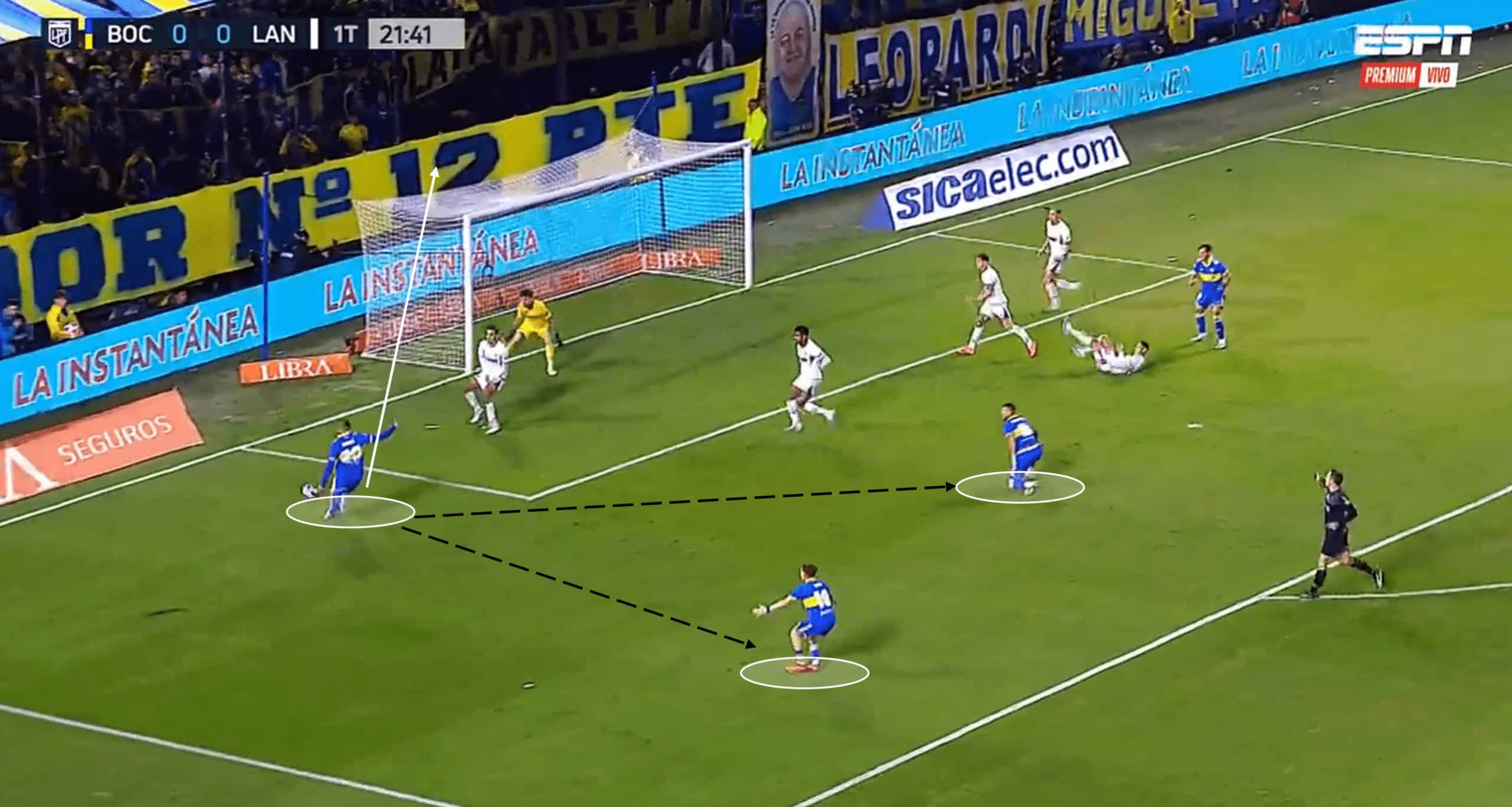
No points for guessing the theme of this example, but just to confirm, yes, it is poor decision-making. Now, there’s a case for the striker in this example hitting the ball first time after the opposition keeper made a good save, but these moments, key moments, require a calm head capable of assessing the options available — we didn’t see that here though.
If you’re going to hit that rebound shot, it needs to be with conviction and on target, at the very least. The shot lacked both of those ingredients. What is more annoying for a Boca supporter is the options the player had in the box with him, both in good space, and both would’ve had a good chance of shooting at goal from a more realistic angle.
Attacking transitions are not being utilised enough.
This segment has some ties to the notion of the need for a plan B in the Boca ranks, but even if that isn’t an option the club want to explore, there are elements in their transition play that need to be improved upon. Our data tells us that Boca has a lower average counterattack rate than their opposition and the second-lowest interception rate in the league, limiting the chance of attacking transitions significantly.
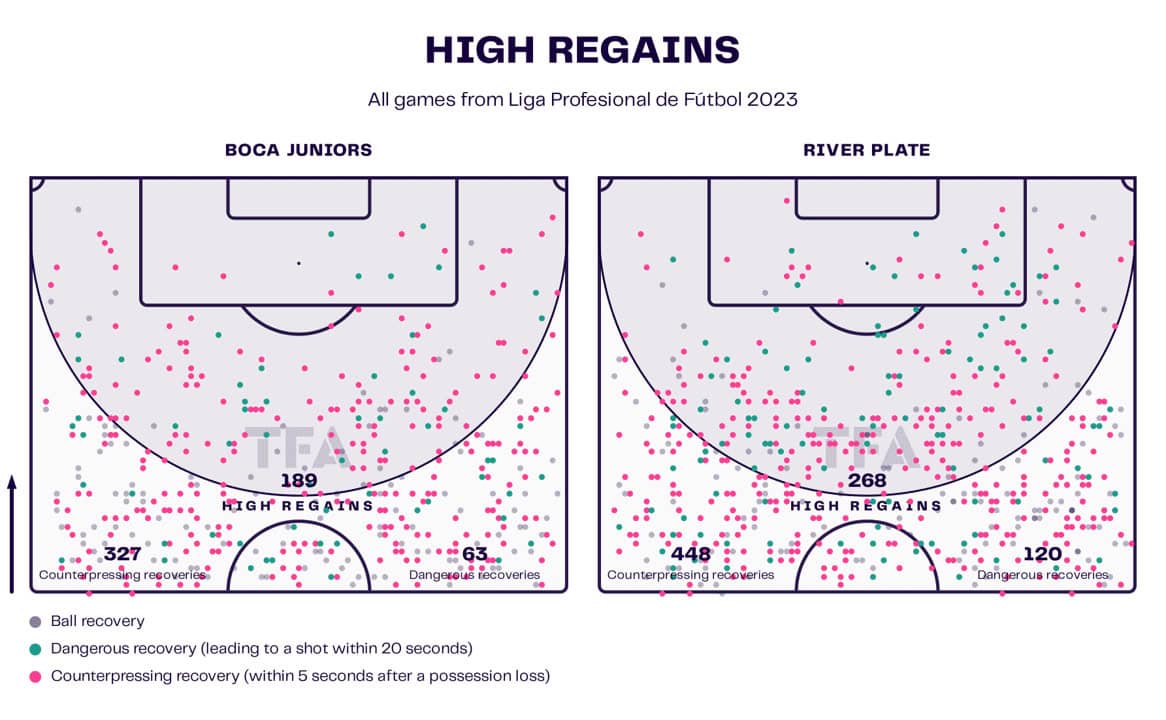
The image above compares Boca’s performance in high regains with that of league leaders River Plate and is used to give us an idea of how effective Boca are in winning the ball back and using those key moments to hurt the opposition. River Plate better Boca in all three data metrics in the image, and the one that Boca would want to focus on first is their low rate of dangerous recoveries — essentially, not many of their transition moments lead to shots within 20 seconds of regaining the ball. As we will see in the following analysis, they tend to slow things down in these times, missing the chance to strike quickly.
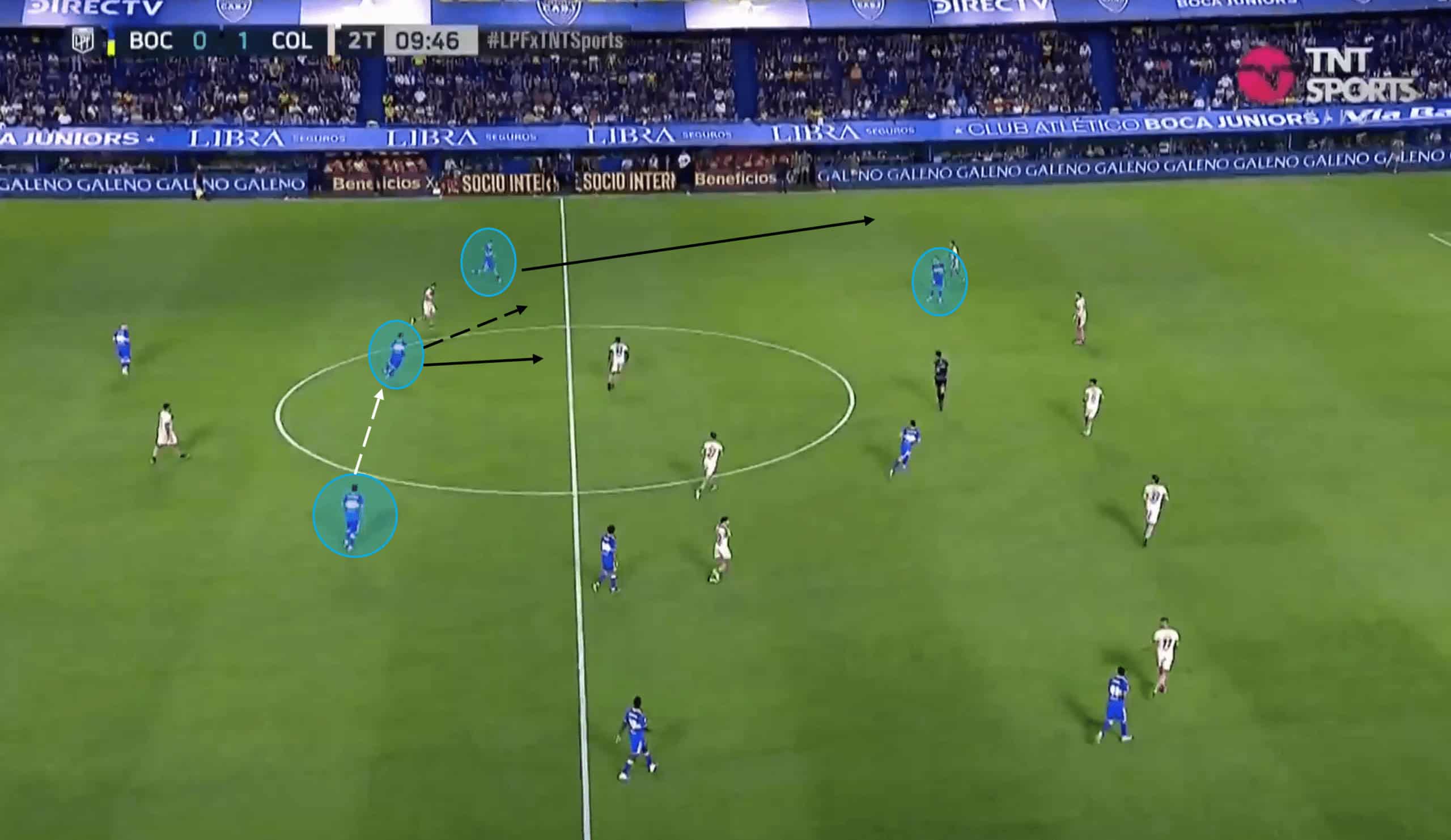
This example reintroduces the questionable decision-making and ties into our previous point about slowing play down in transition moments. Boca shift the ball laterally through midfield nicely following a turnover in possession, and the chance of breaking down the left flank presents itself.
Not only was it a chance to break into space and increase the speed of the attack, but if the pass went out to the left-back. He decided to power on down the flank with the ball; he could’ve created a 2v1 against the opposition RB, significantly increasing Boca’s chance of breaking the opposition down. We didn’t get that, but instead, after a few extra unnecessary touches to slow the play down, the pass went into a more central area, and the move took the direction of Boca having safe possession – which is good. Still, the chance of a real dangerous attack was on the cards.
Possible tactical tweaks – influenced by data
Despite the season being so disappointing for Boca Juniors, there are some positives that they could focus on and make a more prominent feature of their tactics. While they have one of the lowest success rates for aerial duels (most of these will be in midfield areas from instances like goal-kicks/clearances), they have the second-best record in the league for conceding headed goals (just two). So this could influence their defensive approach. While we’re on the topic of headers and aerial stats, they also boast the second-best record for goals from corners this season with five, so clearly, their work on the training ground is paying off there.
We previously mentioned how Boca have several individuals with good technical qualities, which could be a key feature in how they approach attacks next season. While it would require a slight departure from the tactics centred around possession and short passes, playing a more direct and aggressive way could be an option to explore. This season, they rank first for the number of 1v1s & dribbles and rank around the midway point for success. If they lean into this method more, they may find more success. Furthermore, another interesting stat is that they have suffered the most fouls this season, winning 13.78 free kicks per 90 mins in the process. Combining what we know about Boca’s technical ability in certain players with the data about drawing fouls, they could utilise this in earning free kicks in dangerous areas and even penalties.
Speaking of attacking with more directness, they may want to ditch the patient build-up play more often and think about using through passes — they rank third for the number of through pass attempts this season and sit in eighth for accuracy — not a bad ranking pair. Going down this route may involve dropping slightly deeper to encourage the opposition to ditch the deep defending — giving Boca those chances to play through balls in behind the backline.
Conclusion
There is no hiding from the fact that Boca Juniors are in the midst of a horrible campaign, but hope remains for a quick fix for the 2024 season. Jorge Almirón has a lot of work to do, but he has also instilled something of a tactical identity at the club, even if it does require some tweaking to get the best out of his current squad. The season data provides hope as it shows that Boca can play to Almirón’s instructions, so if he can figure out the small details to really get things clicking next season, there is every chance that the players buy into his improved philosophy quickly.






Comments